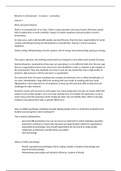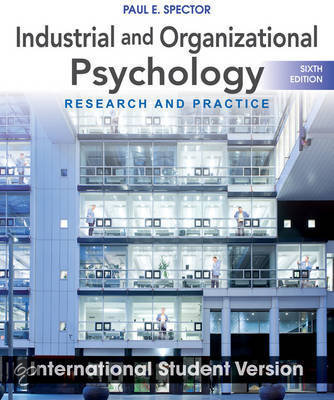Behavior & Environment – 6 lectures – summaries
Lecture 1
Work and work behavior
Work is an essential part of our lives. Work is super prevalent and super invasive (ful-timers spend
half of waking time on work activities). Impact on health, happiness and personality of work is
tremendous.
In many ways, work really benefits people; personal finance, time structure, opportunities for social
contact and lifelong learning and development, social identity, sharing a common purpose,
happiness.
Surface acting; hiding feelings at work, requires a lot of energy versus deep acting; giving you energy.
The scope is dynamic; the working environment has changed to more office work instead of factory.
Societal dynamics; organizations these days are operating in a very different field, then 30 years ago.
Also on a organizational level, they need much more flexibility in order to respond to the changes of
the environment. They also should be very low in costs, be very productive, have a high quality of
products, high pressure is felt by everyone is a organization.
On a personal level, the work is getting more complex and intensive, this is called intensification of
our work. Mentalization; huge shift from working with your hands to working with your head.
Digitalization is also important for all employees to keep up with technical skills to keep their job
(challenge for older workers).
Economic reason why we have to work longer; too many people grow too old, we cannot afford the
medical costs of older people’s care if we stop working early. The healthy life expectancy is not as
much rising as the life expectancy itself. People get older, but not healthy older. Which is strongly
related to educational level with no gender differences.
How can W&O psychology contribute towards helping people work in a motivated, productive and
healthy way during their entire working life?
Three related subdisciplines;
- personnel/HR psychology; how can we ensure an optimal fit in which individual capacities
and desires continue to match work demands and opportunities within the organization?
- organizational psychology; how should organizations be structured to make people
collaborate as efficiently and effectively as possible?
- work psychology
History of W&O psychology
- Wundt; opening first psychological lab in Leipzig, founder of empirical psychology and
experimental psychology
- Münsterberg; psychology and Industrial efficiency, student of Wundt
, - Taylor; engineer, workers acted lazy and did not work efficiently, started studying these
behaviors, time and motion studies
Scientific management assumptions;
- Employee is lazy by nature
- Piecework payment; money is the only motivator
- Managerial control over job performance is essential
Four principles scientific management;
- Scientific approach, time and motion studies
- Selection of right worker for the job, one who could work the most efficiently
- Training and development of worker; based on simple actions and movements
- Strict separation of head and handwork; managers think, workers do
In practice; worker extension of machine, workers were exploited, protests
Henry Ford; first who implemented the ideas of Taylor into his factor, developed assembly line.
During worldwar 2; selection question very important
Current challenges; responsibility for human errors, de-skilling of workers, de-socialization of workers
in platform businesses. Inclusiveness of labour market?
Need to be autonomous, to be competent and to be connected with others.
Lecture 2
Theme 2 organizations, teams and leadership
Organizations; collection of people who work together and coordinate their actions in order to
achieve individual and organizational goals. All companies are organizations, but not all organizations
are companies.
Your vision of an organizations, influences the way you see problems within a organization and how
to fix them.
Organizations are best described as open (in contact with outside environment, keep up with
changes) systems. With input stage, conversion stage and output stage. Importing energy and
transforming energy leads to some sort of output.
- Cycle of events; yearly schedule
- Escaping from entropy; make sure that it can survive and achieves its goals
- Input of information; you need to know what is happening in the outside world, to make sure
they don’t stay behind
- Homeostasis; maintaining balance within organization, despite changes, they can still regain
stability
- Specialization; different departments make sure that a organization can work more efficiently
- Coordination and integration
- Equifinality; more ways to the same outcome, not one solution for a organization to be
effective






